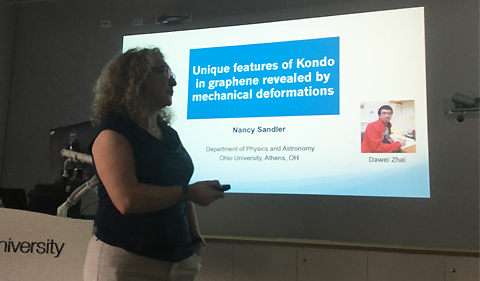
Nancy Sandler presents at Monash University.
By Ryan Flynn
NQPI editorial intern
Nanoscale and Quantum Phenomena Institute 2019 Spring Newsletter
At one atom thick, graphene is the thinnest, flattest material known to date. It is also the most impermeable, and strongest material in the world. It is electrically conductive, flexible, and incredibly lightweight. These attributes make it one of today’s most researched materials, evoking interest from physicists all over the world.
This past December, NQPI member Nancy Sandler, a professor of Physics & Astronomy, was invited to Melbourne, Australia by her colleague, Monash University professor Michael Fuhrer. As chair of the fourth International Conference on Two- Dimensional Materials and Technologies, or ICON-2DMAT 2018, Fuhrer invited Sandler to talk on: “Deformed Graphene Membranes: from Electronic Waveguides to Valley Filters,” i.e. how graphene can be a canal for electrons to travel through.
While in Melbourne, Sandler had the opportunity to visit the FLEET center at Monash University, funded by The Australian Research Council as a Centre of Excellence in Future Low Energy Electronics Technologies. At FLEET, a leading institution for the advancement of electronics, she toured the facilities and presented a seminar on the persistence of magnetic properties for atoms placed on top of graphene.
“I wanted to know if the magnetic nature of the atom was maintained after deposition on graphene and if it depended on the specific position where the atom attached,” Sandler said.
Melbourne, a city crossed by the Yarra River, impressed Sandler with its considerable diversity. She said that people from all over the world mix there with amazing architecture, local art and fantastic food. “It was an honor to be invited to speak at the conference about my research. The hospitality of my hosts and lively culture of Melbourne was the icing on the cake.”



















Comments